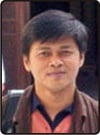The Visual Culture in General Election: A Study on the Implication of Political Policies to the Visualization of Political Parties in Indonesia
Abstract
ABSTRACT: A symbol for a political party does not show only a sign of existence but also an identity and way to connect ideology level to reality level. The General Election which is the first gate to take the power makes a symbol become an important requirement for a political party to participate in the election. The important role that a symbol plays for a political party, especially as an instrument to reach or take over the authority makes the visualization of a political party’s symbol inseparable from the surrounded political system. Those condition and reality are reflected through the visualization of political parties’ symbols participating in the General Elections since 1955 until 2004. How political policies influence the visualization of political parties’ symbols and how political parties respond the space of visual politics are principal questions in this paper. Finally, to get comprehensive answers to those questions, the paper employs the method of history as the research method.
KEY WORDS: Political policies, visualization, symbol, political parties, and General Election in Indonesia.

About the Author: Reiza D. Dienaputra, M.Hum. is an Academic Staff of the History Department, Faculty of Letters UNPAD (University of Padjadjaran) Bandung, West Java, Indonesia; and a Doctoral Candidate of Art and Design Study Program ITB (Bandung Institute of Technology). He can be reached at: reizaputra@unpad.ac.id and reizaputra@yahoo.com
How to cite this article? Dienaputra, Reiza D. (2010). “The Visual Culture in General Election: A Study on the Implication of Political Policies to the Visualization of Political Parties in Indonesia” in TAWARIKH: International Journal for Historical Studies, Vol.2(1) October, pp.93-108. Bandung, Indonesia: ASPENSI [Asosiasi Sarjana Pendidikan Sejarah Indonesia], ISSN 2085-0980.
Chronicle of the article: Accepted (August 12, 2010); Revised (September 24, 2010); and Published (October 28, 2010).
Full Text:
PDFReferences
ANRI [Arsip Nasional Republik Indonesia]. (1999). “Data Pemilihan Umum 1955: Jumlah Kursi DPR Tiap Daerah” in Koleksi Arsip Komisi Pemilihan Umum, 1971 — 1999, No.Inv.1321.
Barnard, Malcolm. (1998). Art, Design and Visual Culture: An Introduction. New York: St. Martin’s Press Inc.
Berger, Arthur Asa. (2005). Tanda-tanda dalam Kebudayaan Kontemporer: Suatu Pengantar Semiotika. Yogyakarta: Tiara Wacana.
Deppen RI [Departemen Penerangan Republik Indonesia]. (1961). Almanak Lembaga2 Negara dan Kepartaian. Djakarta: Deppen RI.
Dienaputra, Reiza D. (1995). “Partai Sarekat Islam: Studi tentang Proses Perubahan Partai Sarekat Islam Menjadi Partai Sarekat Islam Indonesia”. Unpublished Research Report. Bandung: Lemlit UNPAD [Lembaga Penelitian Universitas Padjadjaran].
Elkins, James. (2003). Visual Studies: A Skeptical Introduction. New York and London: Routledge.
Feldman, Edmund Burke. (1967). Art as Image and Idea. New Jersey: Prentice Hall, Inc.
Herusatoto, Budiono. (2008). Simbolisme dalam Budaya Jawa. Yogyakarta: Penerbit Ombak.
Hoed, Benny H. (2008). Semiotik dan Dinamika Sosial-Budaya. Depok: FIPB UI [Fakultas Ilmu Pengetahuan Budaya, Universitas Indonesia].
Karim, M. Rusli. (1983). Perjalanan Partai Politik di Indonesia: Sebuah Potret Pasang-Surut. Jakarta: Rajawali Press.
Kartodirdjo, Sartono. (1983). Pendekatan Ilmu Sosial dalam Metodologi Sejarah. Jakarta: PT Gramedia.
Kartodirdjo, Sartono. (1990). Pengantar Sejarah Indonesia Baru: Sejarah Pergerakan Nasional dari Kolonialisme sampai Nasionalisme. Jakarta: PT Gramedia.
Keputusan Komisi Pemilihan Umum No. 105 Tahun 2003 tentang Tata Cara Penelitian dan Penetapan Partai Politik Menjadi Peserta Pemilihan Umum, tertanggal 30 April 2003.
KPU [Komisi Pemilihan Umum]. (2000). Pemilu 1999 dalam Angka. Jakarta: KPU.
Koch, D.M.G. (1951). Om De Vrijheid: De Nationalistische Beweging in Indonesie. Djakarta: Vorkink.
Piliang, Yasraf A. (2005). Transpolitika: Dinamika Politik di dalam Era Virtualitas. Yogyakarta and Bandung: Jalasutra.
Rochmat, Saefur. (2009). Ilmu Sejarah dalam Perspektif Ilmu Sosial. Yogyakarta: Graha Ilmu.
Sachari, Agus. (2007). Budaya Visual Indonesia. Bandung: Penerbit Erlangga.
Schirato, Tony & Jen-Webb. (2004). Reading the Visual. Australia: Allen & Unwin.
Suryadinata, Leo. (1992), Golkar dan Militer: Studi tentang Budaya Politik. Jakarta: LP3ES.
Suryakusuma, Julia I. et al. (n.d.). API: Almanak Parpol Indonesia. Bogor: SMK Grafika Mardi Yuana.
Tjokrosujoso, Abikusno. (1952). 40 Tahun Partai Sjarekat Islam Indonesia: 10 September 1912 — 10 September 1952. Djakarta: Departemen Penerangan — Propaganda P.S.I.I.
Undang-Undang No. 7 Tahun 1953 tentang Pemilihan Umum Anggota Konstituante dan Anggota Dewan Perwakilan Rakjat, tertanggal 4 April 1953.
Undang-Undang No. 5 Tahun 1969 tentang Pemilihan Umum Anggota-anggota Badan Permusjawaratan/Perwakilan Rakjat, tertanggal 17 Desember 1969.
Undang-Undang No. 3 Tahun 1975 tentang Partai Politik dan Golongan Karya, tertanggal 27 Agustus 1975.
Undang-Undang No. 3 Tahun 1985 tentang Partai Politik dan Golongan Karya, tertanggal 19 Februari 1985.
Undang-Undang No. 22 Tahun 1999 tentang Partai Politik, tertanggal 1 Februari 1999.
Undang-Undang No. 31 Tahun 2002 tentang Partai Politik, tertanggal 27 Desember 2002.
Walsh, W.H. (1959). ”Can History be Objective?” in Hans Meyerhoff [ed]. The Philosophy of History in Our Time: An Anthology. Garden City, New York: Doubleday & Company, Inc.
